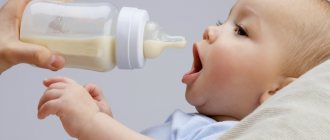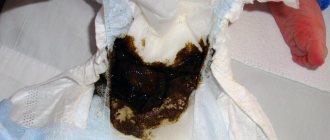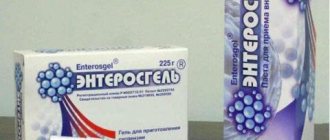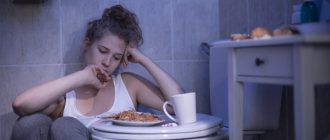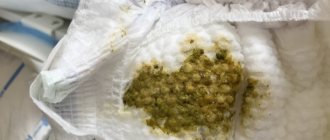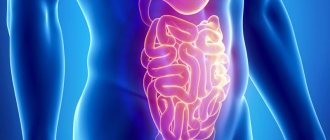The gastrointestinal tract of babies in the first months of life is just beginning to adapt to external conditions. The functioning of the digestive system of small children is unstable, which is why babies often have loose yellow stools.
Watery stool is normal for babies. The exception is cases when painful symptoms appear along with diarrhea. What causes yellow diarrhea in newborns and how to treat it?
What should a normal baby's stool look like?
Normally, bowel movements of breastfed babies can occur up to 10 times a day - after almost every meal. In this way, the newborn’s gastrointestinal tract adapts to the external environment and new food. Then, after a month or two, the frequency of bowel movements decreases. After about 5-6 months, the frequency of stools decreases to 3-5 times a day, and after a year - to two times.
It is normal for a baby to have loose yellow stools. The consistency and color of stool depends on the mother’s diet, as well as the characteristics of the child’s body. For the first one or two days, a newborn’s stool has a watery texture and a greenish tint. After some time, the stool becomes yellow or orange.
In infants who are breastfed, bowel movements occur several times more often than in those babies who are fed formula. This is due to the prolonged digestion of mixtures by the child’s body.
As the baby grows, the color and consistency of stool changes. At first, you need to constantly monitor the child’s condition. And if, in addition to diarrhea, a yellow baby experiences the appearance of pain, as well as mucous, purulent or bloody impurities, it is necessary to sound the alarm and seek the help of a pediatrician as soon as possible.
Why does feces liquefy?
Whether a baby will develop diarrhea is determined by the anatomical and physiological characteristics of his body. But the discharge of liquid yellow feces usually signals an infection of the intestines or poor absorption of food masses. Sometimes liquefied yellowish masses indicate diseases of the biliary system.
The main cause of loose stool in a child under 1 year of age is rotavirus infection. Additional symptoms of the so-called “stomach flu” are:
- persistently high temperature;
- nasal congestion;
- cough and redness of the throat.
Initially, liquid yellow stool is released for 2 days. Subsequently, the shade changes to dirty gray. This condition is not treated with antibiotics because it is associated with viral activity.
Another answer to the question why the baby began to have loose, yellowish stools is the diet disrupted by the nursing mother. Eating forbidden foods and eating inflated portions leads to a change in the nature of children's poop. If mom starts watching her diet, she can refuse the doctor’s services. The diarrhea will stop on its own.
The third point that reveals the secret of passing watery stools is partial sucking of breast milk. The appearance of liquid yellow stool in a baby indicates that the baby satisfies hunger only with foremilk. What does this lead to?
- The fattier product remains in the mammary glands.
- The baby is not getting enough nutrients.
- Milk absorption is incomplete.
- The feces are excreted with a very liquid consistency, sometimes with foam and increased gas formation.
Possible causes of the pathological condition
In an infant, loose yellow stool may be a sign of illness. To find out the exact cause of the disorder, you need to visit a doctor. Often, watery yellow stool in infants is caused by:
- disrupted feeding regimen;
- changing the mother's diet;
- incorrect, early introduction of complementary foods;
- intestinal infections;
- gastrointestinal pathologies;
- overfeeding the child;
- teething;
- lactase deficiency;
- intestinal dysbiosis.
It is also possible that yellow diarrhea may occur in a newborn due to the use of drugs that have antibacterial properties. This group of medications should be prescribed by a pediatrician along with probiotics, which will restore positive microflora and prevent diarrhea.
Excessive salivation, a slight increase in temperature along with liquid yellow stool in an infant may signal teething.
Light diarrhea with foam is caused by physiological dysbacteriosis. The disease often appears in children in the first weeks of life (due to the active colonization of the intestines with new microflora). After about two weeks, in normally developing, full-term newborns who are breastfed, loose yellow stool with water and lumps passes on its own.
Pediatricians do not recommend self-medication. Incorrect therapy, taking medications - all this will have a detrimental effect on the baby’s health. The first thing to do if a newborn has yellow diarrhea is to contact a pediatrician.
Only a doctor can tell why the baby has watery stool, and also, if necessary, select treatment.
Causes of diarrhea
Why does a child have yellow diarrhea? In a young child, loose yellow stools can occur for a number of reasons:
- violation of feeding regime,
- improper introduction of complementary foods,
- changing the diet of a nursing mother,
- intestinal infections,
- diseases of the stomach, pancreas, liver,
- overfeeding the baby,
- intestinal dysbiosis,
- lactase deficiency,
- teething.
In an infant, diarrhea after antibiotics may occur due to the suppression of normal intestinal microflora by antibacterial drugs.
In this case, it is necessary to undergo a stool culture for dysbacteriosis, a stool analysis for opportunistic microflora and coprogram. Based on the test results, the doctor will be able to prescribe adequate treatment. Loose stools in infants often occur during teething. At the same time, the baby begins to salivate profusely and the temperature may even rise slightly.
Frequent, liquid, yellow, foamy stools in a newborn may be a sign of physiological dysbiosis. It occurs during the first two weeks of a child’s life, as the intestines are actively populated by new microflora. At the beginning of the 3rd week in healthy full-term infants after feeding with mother's milk, this condition self-liquidates. Frequent loose stools with white lumps can also be a sign of dysbiosis.
Foamy diarrhea in a child without fever occurs with lactase deficiency, increased gas formation and allergies to foods that the nursing mother eats.
Alarming symptoms
Yellow diarrhea in infants is not always normal. In some cases, this is a manifestation of serious diseases that require treatment. If the illness is accompanied by the following symptoms, you must immediately inform your pediatrician or call an ambulance:
- refusal to eat, loss of appetite;
- increased frequency of bowel movements;
- increase in body temperature;
- the presence of blood, mucus, pus in the stool;
- increased gas formation;
- vomiting;
- sleep disorder;
- dyspeptic disorders.
The baby's constant crying, knocking legs, and lethargy should alert parents. In a baby, loose, yellow stools caused by a pathological cause, that is, a disease, will not go away on their own.
Ignoring an illness, refusing to visit a doctor, or self-medicating is fraught with critical consequences.
Diarrhea during breastfeeding: dangerous symptoms
The appearance of loose stool in a newborn during breastfeeding can be associated with dangerous diseases.
You should consult a doctor if the following symptoms appear in your baby:
- blood in stool;
- vomit;
- temperature increase;
- lack of urination, weight loss;
- refusal to eat, sleep disorder;
- frequent bowel movements;
- crying, pulling your legs towards your stomach when defecating.
A healthy two-month-old baby has bowel movements 10-12 times a day. After 4 months it is reduced to 5 times a day, and after 6 months – 1-2 times.
Possible complications
Prolonged liquid yellow stool in a breastfed or bottle-fed baby is fraught with dehydration and disruption of the gastrointestinal tract. It is not difficult to understand that a baby is suffering from dehydration. Dehydration is accompanied by the following symptoms:
- scanty separation of tear fluid and saliva;
- excessive dryness of the skin;
- retraction of the fontanelle;
- darkening of urine;
- reduction in frequency of urination;
- constant crying, moodiness;
- lethargy;
- sudden weight loss.
Yellow diarrhea in a newborn, complicated by dehydration, in the absence of timely treatment is fraught with critical consequences, in particular death.
The stool is very loose
In children who suck breast milk , apart from the condition, there are no other signs (unpleasant odor or unusual color), such a condition is normal.
Liquid diarrhea in a newborn on an artificial diet may be a sign of intolerance to milk protein (cow's). This intolerance is not entirely uncommon and occurs in 5-7% of children, whether they are breastfed or bottle-fed.
Usually diarrhea is accompanied by painful cramps, the child may lose weight and refuse food.
The body thus protects itself from a substance that harms it .
If the baby is bottle-fed, in consultation with your pediatrician, you will need to change the type of milk . an alternative baby food on our market that is recommended in case of diarrhea.
How to help a baby?
If liquid yellow stool occurs in a newborn, in order to normalize the stool and the baby’s well-being, doctors recommend:
- changing the mother’s diet, excluding from it fatty, fried, spicy and pickled foods, fresh fruits and vegetables;
- breast-feeding;
- refusal to give the baby additional water until the child reaches 6 months;
- changing baby formula if the baby is bottle-fed.
If the loose stool of a newborn during breastfeeding or bottle feeding is prolonged, looks like yellow water (a sign of rotavirus), or is caused by other pathological causes - bacteria, infections, viruses, treatment is necessary.
Symptomatic treatment of yellow diarrhea in a newborn baby involves the use of such medications.
- Rehydrants: electrolyte Humana, Gastrovit, Orasan, Maratonic, Gidrovit. Helps replenish lost fluid and normalize water-salt balance.
- Sorbents: Smecta, Atoxil, Polysorb, Enterosgel, Neosmectin, Lactofiltrum. Helps normalize stool and cleanse the body of harmful substances.
- Antipyretic drugs: Panadol, Efferalgan. Helps in reducing temperature.
Etiotropic treatment of loose stools in infants as yellow water is to use:
- Drugs with antibacterial properties: Nifuroxazide, Cefazolin, Cephabol, Rocephin, Ampicillin (for intestinal infections);
- Probiotics: Lactobacterin, Hilak Forte, Trilacta. Helps restore the balance of intestinal microflora.
Therapy for loose yellow stools, if it is caused by a malfunction of the gastrointestinal tract or a disease of an infectious nature, should be carried out at any age, both a 1-month-old child and a one-year-old child.
Loose stools in infants are normal
The phenomenon of loose stools in a breastfed baby is completely within the normal range. A newborn baby has the right to poop 7-8 times a day (sometimes even more often). His stool is mushy or watery, may have white lumps, usually yellow in color, sometimes with a green or brown tint.
A breastfed baby has a sour-smelling stool, but in babies fed formula, the smell of stool is quite unpleasant, and the color is often greenish (due to the abundance of iron in the formula).
Frequent loose stools in a baby should not cause concern for the mother if the baby looks healthy, happy, eats well and is gaining weight. The boundaries of the norm in this situation are quite blurred - some babies can soil their diaper up to 10 times a day, while others only once every 2-3 days. First of all, rely on the baby’s condition and mood.
But don't forget to watch for warning signs. They are the ones who will tell you when loose stools in a newborn while breastfeeding require increased attention and, possibly, medical attention.
Dr. Komarovsky notes that if a baby has loose yellow stools, this is normal. According to the doctor, diarrhea often occurs during teething, when babies put everything in their mouths that comes to hand, turning into small vacuum cleaners. And also during the period of adjusting the gastrointestinal tract and creating the correct microflora. The main thing is to notice the alarm bells in time.
Prevention measures
Liquid yellow stool in a child of 1, 2, 3 months is normal. If the baby’s condition is good, he is healthy, you should not “stuff” him with medications.
Watery yellow stool in an infant, caused by a disease or intestinal infection, requires treatment. The doctor will tell you what to do and what medications to give the little patient.
It’s easier, after all, to prevent the disorder and the appearance of yellow water in the newborn’s stool. For this it is recommended:
- observe personal hygiene standards (wash your hands, clean your breasts before each feeding);
- do not rush to switch to artificial feeding;
- follow a diet;
- Visit your pediatrician periodically.
Hello, dear readers.
Do you know what problem mothers of infants most often face? Various disorders in the digestive system, stool disorders. Why does diarrhea occur in a newborn, how to distinguish the disease from ordinary loose stools, and most importantly, what should be done if a baby has diarrhea. Let's try to find answers to these important questions.
Causes of yellow diarrhea in a newborn
Yellow diarrhea can be caused by many factors. Some are nothing to worry about, others should be taken seriously. When a newborn has yellow diarrhea, several features should be taken into account:
- This shade of stool in the first year of life can be quite natural if the stool is free of impurities.
- Sudden yellow stools that last for a long time are a sign of the disease.
- In an infant, loose yellow stool can cause dehydration; treatment of diarrhea should be timely and competent.
The reasons why a newborn baby develops loose yellow stool with water may be the following:
- violation of the feeding regime;
- premature or incorrect introduction of complementary foods;
- nutrition for a nursing mother;
- infectious agents;
- diseases affecting the stomach, pancreas or liver;
- overfeeding;
- intestinal dysbiosis;
- teething;
- a consequence of antibiotic therapy - loose stools occur due to an imbalance of intestinal microflora, which is suppressed by antibacterial drugs.
It is important to monitor the regular nutrition of infants, especially at one month of age.
Breastfed
Yellow, loose stool in a healthy breastfed baby is quite normal, unless characteristic changes are observed: acid, foam and lumps. A one-year-old baby eats harder foods that make up his diet; harder feces will be quite normal. The newborn's diet consists exclusively of liquid mother's milk. Parents should be wary of excessive bowel movements and loose stools. Sometimes these symptoms may indicate the following reasons:
- intolerance to foods consumed by a nursing mother;
- eating dirty foods;
- infectious diseases;
- teething;
- reaction to the introduction of complementary foods.
Breastfed children tolerate intestinal adaptation more easily than formula-fed children. There is a risk of diarrhea if the mother's diet is poor. In such a case, it is enough to exclude the product that caused the diarrhea.
Artificially fed
Formula-fed babies are more susceptible to intestinal upset. This is due to the baby’s underdeveloped digestive organs. It is still difficult for him to digest fats, proteins and carbohydrates; the mixture is not completely absorbed. Diarrhea in a child can be caused by the following reasons:
- The disease is celiac enteropathy. Characterized by impaired absorption in the intestine, the small intestine undergoes atrophy. The reason is gluten, a substance that babies do not always digest successfully due to the lack of the required amount of enzymes that break down the substance. Symptoms of celiac disease include foamy stools, decreased appetite, lethargy, and weight loss. In laboratory tests, pathogenic microorganisms are not detected, which is the main factor in the inability to digest gluten. Therapy involves a diet that excludes gluten-containing foods, including wheat, rye or oats.
- Replacing the mixture. It is highly not recommended to suddenly switch from using one mixture to another. Baby food differs in composition, and the baby’s digestive system is not so versatile as to assimilate a new product. In addition to bowel dysfunction, the child develops a skin rash and excessive gas formation. These factors irritate the baby. If the transition is forced, you must remember to gradually add a new product to the artificial diet.
- Intestinal dysbiosis. Together with breast milk, the baby receives beneficial bacteria that inhabit the microflora and contribute to the proper functioning of the gastrointestinal tract. Formula-fed babies do not have this privilege; an imbalance in the intestines may occur. Microbes begin to multiply at an accelerated pace, and the child simply does not have beneficial bacteria to fight them. It is necessary to treat dysbacteriosis with means that restore the microflora.
Loose stools or diarrhea - what's the difference?
A newborn has yellow diarrhea, a paste-like consistency with a pronounced sour-milk odor - the norm for a breastfed baby. Infants up to 2 months empty their intestines after each feeding, approximately 5-7 times a day, artificial ones somewhat less often. By the end of the third month, the stool becomes denser, turns brown, and bowel movements occur 2-3 times a day.
A change in the color and consistency of stool is observed with the introduction of complementary foods, which is associated with a reaction to new food. The stool is fully formed by 8-9 months.
- the feces have become very liquid, foamy, and there is a general deterioration in the child’s condition;
- bowel movements occur much more often, sometimes defecation occurs through a sudden release;
- feces have a strong unpleasant odor, become green, swampy, dark in color, which indicates infection with pathogenic bacteria; with dysentery, the feces are bright and multi-colored;
- feces contain impurities of mucus, blood, pus, a lot of undigested milk or food;
- the skin around the anus turns red;
- the temperature rises or falls, nausea, vomiting, signs of dehydration and intoxication appear, the baby burps more often than usual;
- weight loss is observed;
- the skin becomes pale.
Sometimes diarrhea goes away on its own within 1-2 days; severe forms of the disease require specialist intervention.
Causes of diarrhea in a child
Diarrhea in a child can be caused by various reasons; they do not always pose a serious threat to the baby. Hypothermia, overheating, and fatigue can trigger diarrhea.
Why does diarrhea occur in newborns?
In breastfed children, diarrhea is often caused by the mother's poor diet. If you eat a lot of fresh vegetables and fruits, fatty meats, and herbs during lactation, then you cannot avoid digestive problems in your baby.
- Products that cause allergies.
Food allergies often occur due to a lack of enzymes. It is necessary to monitor which foods cause diarrhea and exclude them from the child’s diet.
- The child's body does not absorb food components.
Poor digestibility of lactose, gluten, cystic fibrosis - with such pathologies, the child does not gain weight well, and a rash often appears on the skin.
Fever, diarrhea, increased moodiness, refusal to eat, excessive salivation - if these symptoms appear in a baby older than 6 months, carefully examine the gums; their redness and swelling indicate the imminent appearance of a baby tooth.
- Intestinal infections.
Vomiting, fever, frequent diarrhea. If the cause of diarrhea is salmonella, dysentery bacillus, or amoebas, then due to severe dehydration and heat, convulsions may begin, and the fontanelle may sink.
Disturbances in the balance of intestinal microflora often occur in infants under six months of age. In older children, a similar problem may arise after antibiotic therapy.
Diarrhea is accompanied by abdominal pain, allergic reactions, and signs of a cold.
Diarrhea often occurs in children due to colds and flu.
Diarrhea, acute pain, bloated abdomen, increased gas formation, bloating, a sharp increase in temperature, severe vomiting - these signs also indicate inflammation of the appendix, peritonitis, and intestinal obstruction. All pathologies require immediate surgical intervention.
When to see a doctor
Watery stool in a bottle-fed or breastfed baby should alert you if the following symptoms are present:
- vomit;
- restlessness and moodiness;
- weight loss;
- poor sleep;
- lethargy and weak crying without tears;
- putrid smell of feces;
- impurities of blood, mucus in feces;
- change in urine color;
- gas formation;
- abdominal pain;
- refusal to eat;
- lumps, greens in stool;
- elevated body temperature.
Diarrhea is dangerous for your baby! It doesn’t matter how old the child is - a month or a year old, he is susceptible to dehydration and the development of serious complications in the form of developmental delays, the transition to a chronic disease, and even death.
An infant may diarrhea for various reasons, and first it is necessary to examine the stool, and then the condition of the child. If there are no accompanying symptoms, study the composition of the formula or the mother's diet. If your newborn's water diarrhea does not stop within 1-2 days, consult a doctor. Don't self-medicate!
The article was approved by the editors
How to give first aid
Many mothers begin to panic when they first encounter severe diarrhea in a child, but there is no time to waste time worrying - diarrhea in a baby quickly leads to dehydration, which is extremely dangerous for small children. Signs of dehydration are rapid weight loss, lack of urination for more than 4 hours, crying without tears, dry lips, and the child becomes lethargic.
How to help your baby
If diarrhea occurs in an acute form, any treatment can be started only after consulting a doctor.
The main causes of diarrhea during breastfeeding
If a mother discovers diarrhea in her baby, there may be many reasons for it. Each of them requires its own specific treatment, so you cannot choose medications on your own and try to treat the child. Only a doctor can determine the actual causes of loose stools in a baby, so at the first symptoms of a dangerous condition, you must seek his help.
Microflora disturbance, deficiency of digestive enzymes
One of the reasons for diarrhea in a baby may be a violation of the intestinal microflora. With dysbacteriosis, the stool is liquid, with a greenish tint, often with mucus, and sometimes foamy stools. It can be caused by a course of antibiotic treatment, so for recovery it is often recommended to take pro- and prebiotic drugs. They help restore intestinal microflora and improve digestion.
Many mothers in the maternity hospital are recommended to give their baby Bifidumbacterin to populate the intestines with beneficial bacteria; it can also be useful for diarrhea. In addition to it, babies under 12 months are often prescribed Linex, Probifor, Acipol and Lactobacterin. But the choice of a suitable medicine, its dosage - all this should be in the competence of the doctor, not the mother.
Another cause of the disorder is sometimes a deficiency or absence of necessary enzymes.
- Lactose intolerance appears from the first days of life. The stool becomes green, foamy, with a sour odor; the child also experiences colic, vomiting and acute toxicosis.
- Celiac disease is the inability to break down the gluten peptide due to a lack of necessary enzymes. Symptoms do not appear immediately, but only several months after the introduction of cereals to the baby’s menu. He develops diarrhea, with foam and shine, which smells very unpleasant. The girth of the tummy increases with general malnutrition.
- Cystic fibrosis is a congenital disease affecting the endocrine glands, lungs and gastrointestinal tract. Food is poorly digested, so the baby's stool is viscous, has an unpleasant odor and is very frequent.
Each type of intolerance requires the exclusion of certain foods (milk, cereals) from the diet and the use of enzyme-containing medications.
Intestinal infection
One of the causes of diarrhea in a breastfeeding baby is intestinal infections. Symptoms can be different - they depend on the specific pathogen. But almost always the main symptoms will be vomiting, fever and diarrhea in an infant.
If the baby's small intestinal walls become inflamed, the stool becomes profuse, watery, streaked with blood and mucus. An increase in temperature, vomiting and green stool indicate rotavirus infection, and foamy poop indicates staphylococcal enterocolitis. Only a doctor can determine the final diagnosis and appropriate treatment.
Features of stool in infants
The color and consistency of feces in infants depends on the mother’s nutrition, as well as on the characteristics of the child’s body. In newborns, the first stool (meconium) is released and is green, black or dark brown in color. Over time, the stool becomes yellow in color.
When breastfeeding, a newborn has yellow stools 6–8 times a day. Some children pass feces with a sour smell after every satiation and contain lumps of curdled milk. The consistency of stool is normally mushy, but it can also be liquid. Yellow diarrhea in a child without fever is not considered a pathology if the child is calmly and steadily gaining weight. Shows no signs of anxiety during bowel movements.
After adding complementary foods, the stool becomes denser. In one-year-old infants, bowel movements occur 1–2 times a day.
Signs such as pulling the legs toward the stomach and frequent crying indicate disturbances in the functioning of the intestines. Pathology is indicated by mucus in the poop, blood and purulent impurities, changes in the color and smell of feces. We wrote about green diarrhea here.
Normal stool in a baby
Diarrhea is an increase in the frequency of bowel movements. The intestinal motor function of a one-month-old baby is quite energetic, which is manifested by frequent bowel movements: in the first two weeks in a newborn - 3-5 times, during the first year of life - 1-3 times a day, in a one-year-old child - 1-2 times a day. In infants, the process of defecation is a spontaneous (reflex) act, and starting from two years of age, bowel movements are a voluntary (conscious) process.
The child's first bowel movement occurs during the first day of life and is called meconium (original feces). It consists of epithelial cells, bile, enzymes and has a greenish-black color. The manifestation of meconium is necessarily recorded in the developmental history of the newborn, as this indicates intestinal patency. The stool of a breastfed baby is yellow in color and has the consistency of liquid sour cream with a sour odor.
Since artificial formulas for feeding are absorbed in the gastrointestinal tract longer than breast milk, the baby can defecate 2 times less often. At the same time, the volume of feces will be greater. The stool of a formula-fed baby is light yellow in color with an unpleasant odor. If the feeding formula is poorly absorbed in the digestive tract, white lumps may appear in the stool.
A child's normal stool ranges in color from bright yellow to light yellow. The color of stool begins to change and becomes brown only after the introduction of complementary foods at 6 months. In the first year of a child’s life, loose, yellow stools are not a pathology and do not require treatment.
Causes of the disorder
Babies fed with breast milk have a lower risk of getting an intestinal infection than with formula feeding.
In infants, yellow diarrhea occurs for various reasons:
- When overfeeding or feeding thick food inappropriate for age, the baby’s stomach copes with the increased volume for some time. Over time, enzyme depletion occurs. Undigested food enters the intestines, which disrupts the normal microflora. The consequence is the proliferation of pathological microorganisms with digestive disorders. Abdominal bloating appears. The child passes yellow liquid stool in a stream along with gases.
- Lactase intolerance in infants manifests itself as diarrhea and flatulence after 2 minutes, in older children - 2 hours after consuming milk, including breast milk. There is no mucus or blood in the stool. Children with lactase deficiency are underweight. They have rashes on their body. The examination reveals iron deficiency anemia, which cannot be treated.
- A child often experiences yellow, loose stools during teething. This period is sometimes accompanied by elevated temperature. The baby is drooling and his gums are red. Children cry in pain and refuse to eat. Gels selected by the pediatrician alleviate the child’s condition.
- Persistent yellow diarrhea occurs when you are allergic to cow's milk protein. Diarrhea is accompanied by bloating and delayed weight gain. Sometimes a skin rash appears.
- Diarrhea with yellow water in a child, in addition to infection, causes an allergic reaction to food. Simultaneously with foamy feces, repeated vomiting occurs. This condition occurs only when eating certain foods.
- Taking medications, especially antibiotics, causes the death of normal microflora in the intestines. As a result, dysbiosis develops, a sign of which may be bright yellow feces and bloating.
- Light yellow diarrhea in a child can occur due to helminthic infestation. Infection occurs through contact with indoor and outdoor cats, dogs, as well as children suffering from helminthiasis. Diarrhea may be accompanied by a rise in temperature to subfebrile levels and abdominal cramps.
- Yellow diarrhea with foam in a child is characteristic of gluten enteropathy - celiac disease. The disease manifests itself in children 1-2 years old with abdominal pain, decreased appetite, and vomiting.
- Foamy stool occurs with dysbacteriosis. It is characterized by foul-smelling feces, weight loss, intestinal colic, and dark circles under the eyes.
Diarrhea at an early age sometimes appears due to diseases not related to the digestive system - ARVI, otitis media, bronchitis or influenza.
Possible causes of yellow diarrhea
Experts say that treatment of the disease is effective only when the root cause is determined. Liquid, yellow stool in a child is considered a symptom, which is not always effective to relieve.
It is important to see a doctor if you experience foamy or severe diarrhea. You should not make a diagnosis yourself or do it over the Internet. It is undesirable to waste time in such a situation.
If a child has yellow, loose stools, and other symptoms of intoxication appear and their health worsens, medical attention is necessary. The following factors can lead to the problem:
- Poor nutrition. Young children often experience bowel problems due to poor diet. In infants, diarrhea occurs when the mother’s diet is poor: the cause may be an abundance of fatty or spicy foods. New foods should be introduced gradually and carefully.
- Indigestion. The reasons may lie not only in disruption of the lower gastrointestinal tract, but also in diseases of the stomach. Insufficiently digested food irritates the intestines and provokes disorders.
- Pancreatitis. Inflammation of the pancreas is often accompanied by loose, watery stools. In this case, other symptoms appear: nausea, vomiting, weakness, fever, severe pain in the abdominal area.
- Liver diseases. This organ produces bile necessary for normal digestion. It gives the stool a brownish tint. Light yellow stool may be a sign of serious liver disease.
- Worm infestations. Intestinal parasite damage leads to diarrhea, abdominal pain and other unpleasant symptoms. In this case, the stool can be of any color, but more often it is liquid and watery.
Changes in the color of feces sometimes indicate bacterial infection of the intestines with streptococci or staphylococci. These microorganisms can cause an infectious-inflammatory process and lead to various complications. An examination will help determine the exact cause of the disease: blood and stool tests, smear culture.
First aid for yellow diarrhea in a child
Intestinal infections affect children of any age.
The disease poses a great danger to infants. They quickly lose fluid, which if left untreated can be fatal.
If you become ill, you should call a doctor if your child has yellow diarrhea accompanied by vomiting and signs of dehydration:
- dry tongue, lips and skin;
- sunken eyes;
- cold hands, feet;
- dark urine with a strong odor;
- no urine output for 6 hours;
- The baby refuses to drink water.
Measures before the ambulance arrives:
- The child should be given 1 tsp of water. every quarter of an hour. In addition, it is necessary to restore the water-salt balance. For this, diluted Regidron powder is prescribed.
- If the temperature is above 38.5 °C, you need to give the baby Paracetamol syrup or put a rectal suppository with this drug. Remove the child's clothes and dry the skin with cool water.
- If there is no vomiting, the patient should be given a solution of enterosorbent - Smecta, Enterosgel or Filtrum STI to drink.
After taking measures, continue to give water until the doctors arrive.
Yellow diarrhea in newborns
The baby often experiences changes in the color, consistency, and frequency of stool. Since children are different from adults, infant stool becomes the source of many questions and concerns for parents - is this type of stool normal for a newborn, why does the child have green, loose stool? To understand what the contents of a baby’s diaper says about his health, what are the causes of diarrhea in a baby, how to treat diarrhea in a child so that he feels better quickly, will help a candidate of medical sciences, a doctor of the highest category, a pediatrician and deputy head of a children’s hospital. Savelovskaya Alla Anatolyevna Shcherbakova.
— Alla Anatolyevna, please tell us what diarrhea (diarrhea) is in a baby.
— Diarrhea is a disease, a functional disorder of the gastrointestinal tract, which is accompanied by loose stools. There is a Bristol stool scale, according to which diarrhea is considered to be liquid or semi-liquid with solid lumps. Diarrhea is not typical for healthy children.
— What are the symptoms of this problem and how can a mother distinguish diarrhea from normal feces?
— Diarrhea in young children is quite rare. However, according to statistics from the World Health Organization, a functional disorder of the gastrointestinal tract, accompanied by diarrhea, is in second place among the causes of death in children of the first year of life.
- Loose stool in a baby is normal.
A child of the first and second months of life has stools of a more liquid consistency than an adult. If the baby has stool the consistency of an egg yolk and has bowel movements after each feeding, but gains weight well, eats and sleeps, is cheerful and does not cry, then this should not cause concern to the mother.
Important!
Diarrhea is not just loose stool. If a child does not gain weight in the first months of life and has frequent watery, foamy or loose stools with mucus or blood, this is a reason to immediately contact your pediatrician.
— Alla Anatolyevna, what can cause diarrhea in a baby?
— For a child in the first months of life, the main cause of diarrhea is food intolerance; for a child in the second half of life and the second year of life, it is an intestinal infection of a viral nature. But why a baby has diarrhea, a doctor must decide in each case.
Food allergy in an infant
occurs on the food he receives, most often cow's milk protein. Causes of allergies in infants:
- in a child who is exclusively breastfed - consumption of dairy products by the nursing mother;
- in a bottle-fed child - a reaction to cow's milk protein;
- A mixed-fed baby is more allergic to formula milk, and to a lesser extent allergic to mother's milk.
Infection of infants with intestinal infections
occurs through dirty palms and toys (when a child begins to crawl, pick up objects from the floor with his own hands, play outside).
Signs of an intestinal infection in a child:
- refusal to eat;
- decreased appetite;
- temperature increase;
- vomit.
— What does the color of the stool of a breastfed and bottle-fed baby indicate? What are the norms and dangerous situations?
— Bile pigments, which are produced by the liver, accumulate in the gallbladder and are released during nutrition, helping digestion, are responsible for the color of stool. They turn the baby's stool yellow, green, or olive green. Therefore, if the child feels well and gains weight well, and the stool has a greenish-yellow tint, this is the norm for up to a year.
- An infant has yellow diarrhea.
If a 4, 5 or 6 month old child has yellow stool and the temperature has risen, the stool has become more frequent and watery and profuse, and appetite has decreased - these are signs of an intestinal infection.
- The baby has diarrhea with mucus.
Mucus in the stool is the product of the activity of intestinal goblet cells, which secrete mucus. Mucus in a child’s stool is a sign of inflammatory colitis of the colon (an indicator of a food allergy or the final stage of an intestinal infection). There should be no mucus in the stool.
- Diarrhea without fever in a child - what can this mean and what should the mother do?
— Do not ignore diarrhea without fever in an infant. This may be a manifestation of pathological conditions. Such as:
- Food allergy - its cause will be determined by a doctor, who will also tell you what the mother needs to do.
- Antibiotic-associated diarrhea - in children it occurs during treatment of an infectious disease that is associated with the activity of clostridia and their toxins, which is accompanied by diarrhea with blood. This serious condition requires seeing a doctor.
- Gluten intolerance - prolonged diarrhea with celiac disease does not respond to traditional treatment and is not similar to the course of an intestinal infection. The assumption of the presence of such a disease requires additional examination, observation and, at a minimum, consultation with a competent pediatrician and pediatric gastroenterologist.
Treatment of yellow stool in a child
If the baby, after being examined by a doctor, is left at home for outpatient treatment, the main thing is to prevent dehydration and loss of important salts. To achieve this, measures are being taken:
- Fractional feeding of the baby with water, 1 tsp each. every 10–15 minutes. Use salt solutions - Regidron, Oralit, Glucosolan. The medicine is quickly prepared at home. Dissolve 2 tbsp in one liter of chilled boiled water. l. sugar, 1 tsp. salt and baking soda. The child should be given this solution, alternating with water.
- Medicines containing lacto- and bifidobacteria (Acipol, Linex) are used. By becoming more active and multiplying, they improve digestion and stop diarrhea.
- Sorbents such as Smecta, Enterosgel, Polyphepan, approved for use by newborns, help treat light yellow diarrhea in a child.
- In the first hours of illness, do not stop diarrhea and vomiting with medications. The body cleanses itself of bacteria and toxins.
- In case of allergies, diarrhea is eliminated by eliminating the allergen product from the child’s diet and prescribing antihistamines.
Drinking and recommended measures at all stages of the disease help cope with the infection.
Treatment of diarrhea in infants
Even if the baby’s condition does not cause concern to parents, yellow diarrhea should not be ignored. After all, diarrhea leads to dehydration, and this is already a rather dangerous condition. Its consequence can be hospitalization and even death of the child.
It is very important to remember dehydration syndromes well, so that if something happens you don’t waste time:
- strong thirst;
- dry skin;
- dry mucous membranes;
- sinking fontanelles;
- sunken eyes;
- lethargy, drowsiness of the child;
- weight loss.
Therefore, the first answer to the question of what to do if a newborn has yellow diarrhea is to put it to the breast more often, and, if necessary, give it more water. This can be water or decoctions. However, if the child is not yet a year old, it is better to be careful with herbal decoctions, since some of them are quite potent.
Carefully read the instructions for herbs for decoction and purchase them only in pharmacies.
You can resort to traditional methods of treating diarrhea. For example, rice water helps very well. To prepare it, you need to take one part rice and three parts water and bring to a boil. The product is given to the child one tablespoon every two hours.
A remedy such as chamomile and mint tea helps with diarrhea. Herbs are mixed in equal proportions. Place a teaspoon of the mixture in a glass, pour boiling water over it and cool to an acceptable temperature. This tea is drunk in small sips in 4-5 doses per day.
To fix the stool, you can give the child smecta to drink. Children under one year old are given 1-2 sachets of the product per day. You can dilute it with milk or formula if he is less than 3 months old, or with boiled water if the baby is older. Before use, the mixture must be shaken, as the smecta settles to the bottom. The mixture is divided into equal portions, a teaspoon each, and given to the child regularly. The course lasts 3 days.
Activated carbon can also be a good remedy for diarrhea, which, like smecta, draws out all toxins and cleanses the intestines. However, it is not absorbed into the blood, but passes through the intestines through. Babies up to one year old are given 1 tablet per day divided into several doses.
Nutrition for diarrhea
For children under one year old, the best food is breast milk. It is recommended to increase the number of breastfeedings by 1–3 times, but reduce the amount of milk per feeding. With a mild intestinal infection, the daily amount of food is reduced by 20%. With moderate severity of the disease, the diet is reduced by 30% and divided into 5-6 doses. In case of severe infection, the amount of food is reduced by 50%.
Artificial children are given the usual mixtures. Fermented milk NAN, Gallia Lactofidus 1, Agusha 1 are preferred. For moderate infections, low-lactose mixture Nutrilon or lactose-free Mamex should be used.
Traditional methods for yellow diarrhea
If a child has white-yellow diarrhea, time-tested folk remedies help:
- Dill water helps reduce intestinal colic at any age. The product has carminative and antispasmodic properties. To prepare the product, add 1 tsp to 300 ml of water. dill seeds After boiling, remove from heat and leave covered for 40 minutes. Infants are given 1 tsp. 3–4 times a day.
- Melissa seeds have an anti-inflammatory effect against digestive disorders. Essential oils relieve intestinal spasms. To prepare the solution 4 tbsp. l. leave the herbs in a glass of boiling water in a water bath for 20 minutes. The infusion is given after straining, 1 tsp. three times a day.
- Cumin eliminates diarrhea and bloating in infants. The solution is prepared in a ratio of 2 tbsp. l. seeds per glass of boiling water. After a quarter of an hour of infusion in a thermos, the finished infusion is used 1 tsp. 3 times a day.
Folk remedies are used only in the complex treatment of intestinal infections or mild diarrhea in children of any age.
Prevention
If yellow diarrhea occurs in a breastfed baby, the mother needs to adhere to a diet. Foods that cause digestive upset in the baby are excluded from the diet. There are simple ways to prevent diarrhea:
- Give children only bottled or boiled water;
- use safe food products taking into account expiration dates;
- mother needs to maintain body and hand hygiene before feeding;
- introduce complementary foods after consulting a pediatrician;
- regular hygiene procedures for caring for the baby, wet cleaning of his room, washing toys;
- compliance with the frequency of feedings and amount of food recommended by the doctor according to age.
If diarrhea does appear, do not delay a visit to the pediatrician. Self-medication delays proper treatment and leads to complications of the disease.
WHO (World Health Organization) recommends breastfeeding babies for at least 6 months after birth. Breastfed babies suffer from intestinal infections half as often as bottle-fed babies. Maintaining good hygiene reduces the risk of digestive disorders.
Causes of yellow diarrhea in a child under one year old
Yellow diarrhea in a newborn is not uncommon. This is due to a whole list of reasons.
Among them are the following:
- immaturity of the gastrointestinal tract of a small child;
- binge eating;
- food allergies;
- food poisoning;
- infectious diseases;
- taking medications;
- dysbacteriosis;
- underdevelopment of the digestive organs.
Most often, of course, the causes of diarrhea are found at the top of the list and do not entail any complications. But this does not mean that parents can ignore the yellow diarrhea that occurs in their child. It is very important to closely monitor the baby.
One of the problems of yellow diarrhea in a child was examined by Dr. Komarovsky:
If diarrhea is a one-time occurrence or passes over a period of time and is not accompanied by fever, changes in the baby’s appetite or well-being, then there is nothing to worry about. Most likely, the child simply overate or the immature intestines for some reason could not cope with the food.
It is also possible that feeding rules were not followed: for example, the bottle was not sterilized before preparing the formula. If he was given some new product that day, then perhaps he should refuse it for now.
Why else can a breastfed newborn have yellow diarrhea? Of course, because mom ate something wrong. If a woman has somehow changed her diet, then she should give up new products, spices or some cooking methods.

